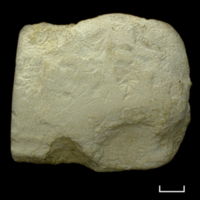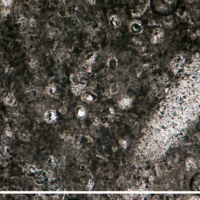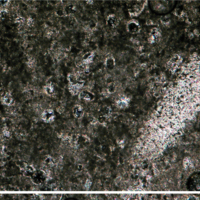- Home
- Rocks
- Type fossils
- Fossil Specimens
- Minerals
- Glossary
- Stratigraphic Chart
- Michel-Levy Chart
- Classification of igneous rocks
- University of Cambridge
- Department of Earth Sciences
- ESC Library
- Moodle
- Sedgwick Museum
- DoITPoMS
- Mindat.org
- Microfossils
- Bryozoans
- Webmineral
- Tree of Life
- CrystalMaker
- Virtual Microscope
L351 - Limestone, micrite (chalk)
Hand Specimen
This white rock is virtually pure carbonate. It fizzes with acid. It is fine-grained and poorly cemented, making it soft and low density. It is commonly known as ‘chalk’.
Thin-section
Very uniform cryptocrystalline carbonate.
Rare larger calcite crystals <0.5mm.
Rock History
Very fine-grained, so deposited in a very low energy environment.
Such fine carbonate could have been produced in one of two ways:
1. Tests of calcitic plankton.
2. Very finely ground shell fragments. Currents alone could not grind the shells this finely. This would require bioerosion – e.g. fish ingesting organisms with carbonate shells, and grinding the carbonate to a fine powder.
Such fine carbonate could have been produced in one of two ways:
1. Tests of calcitic plankton.
2. Very finely ground shell fragments. Currents alone could not grind the shells this finely. This would require bioerosion – e.g. fish ingesting organisms with carbonate shells, and grinding the carbonate to a fine powder.
Rock Name
limestone
mustone
micrite
chalk
mustone
micrite
chalk



